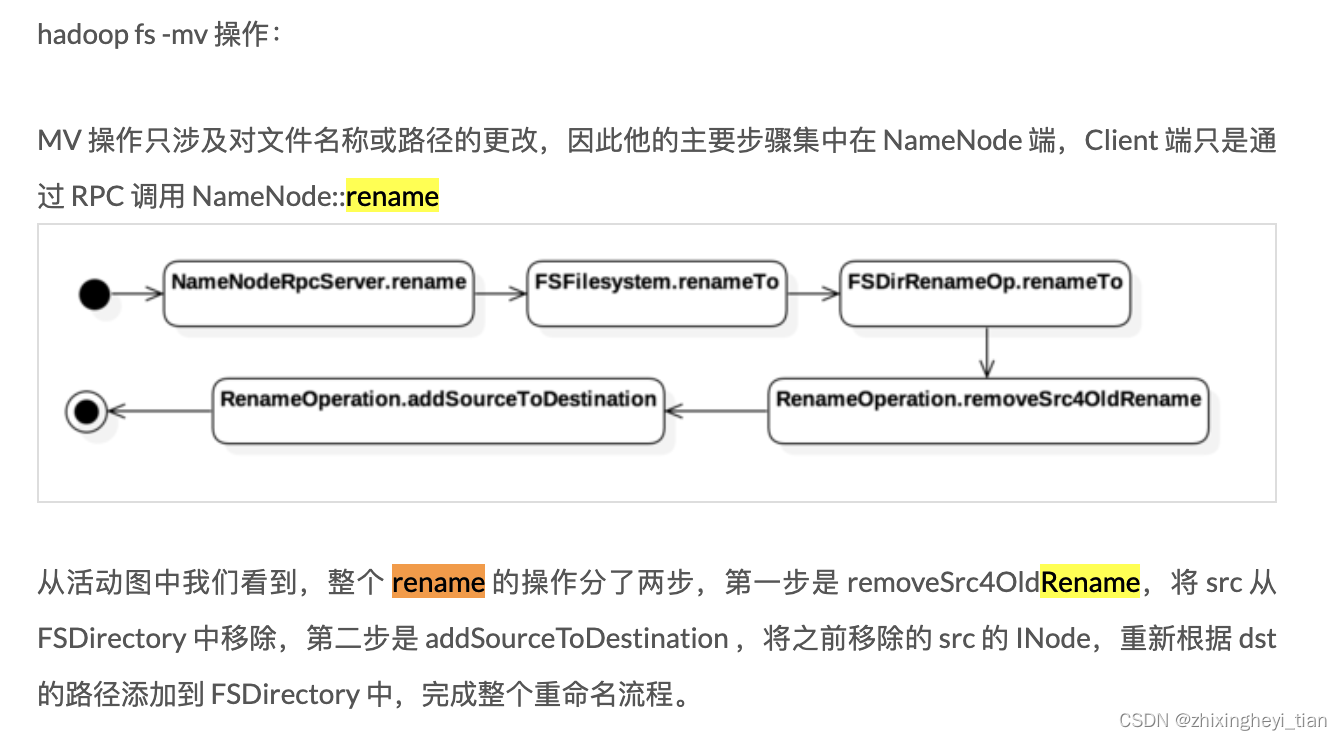DFSClient 是应用程序访问hdfs的主要入口类
其方法调用最终通过RPC通信触发服务端响应请求。
以 rename方法为例,介绍整个流程
public void rename(String src, String dst, Options.Rename... options)
throws IOException {
checkOpen();
try {
namenode.rename2(src, dst, options);
}
...
}
最终调用namenode 的方法
##接下来 看下 namenode 是怎么构造出来的
先介绍两个协议
ClientProtocol协议
该协议定义了和名字节点交互的所有方法(如rename等方法)
@InterfaceAudience.Private
@InterfaceStability.Evolving
@KerberosInfo(
serverPrincipal = DFSConfigKeys.DFS_NAMENODE_KERBEROS_PRINCIPAL_KEY)
@TokenInfo(DelegationTokenSelector.class)
public interface ClientProtocol {
...
}
由此可见 ClientProtocol 其实就是一个 interface 定义
它有两个重要的子类
- ClientNamenodeProtocolTranslatorPB 用于 client 端,发送请求
- NameNodeRpcServer 用于server端,处理请求
###ClientNamenodeProtocolPB 协议
ClientNamenodeProtocol.proto 生成 ClientNamenodeProtocolProtos.java
ClientNamenodeProtocolProtos 定义了 ClientNamenodeProtocol.BlockingInterface 接口
ClientNamenodeProtocolPB 继承了 这个 BlockingInterface
public interface ClientNamenodeProtocolPB extends
ClientNamenodeProtocol.BlockingInterface {
}
ClientNamenodeProtocolPB 这个接口协议 用处 是将ClientProtocol 各种方法 进行 protobuf 序列化包装,以便RPC进行调用
DFSClient 构造函数中
this.namenode = proxyInfo.getProxy();
proxyInfo 的来历是
proxyInfo = NameNodeProxies.createProxy(conf, nameNodeUri,
ClientProtocol.class, nnFallbackToSimpleAuth);
在非HA模式下 createProxy最终执行于
if (failoverProxyProvider == null) {
// Non-HA case
return createNonHAProxy(conf, NameNode.getAddress(nameNodeUri), xface,
UserGroupInformation.getCurrentUser(), true, fallbackToSimpleAuth);
}
createNonHAProxy执行于
T proxy;
if (xface == ClientProtocol.class) {
proxy = (T) createNNProxyWithClientProtocol(nnAddr, conf, ugi,
withRetries, fallbackToSimpleAuth);
}
createNNProxyWithClientProtocol 关键代码如下
private static ClientProtocol createNNProxyWithClientProtocol
{
...
ClientNamenodeProtocolPB proxy = RPC.getProtocolProxy(
ClientNamenodeProtocolPB.class, version, address, ugi, conf,
NetUtils.getDefaultSocketFactory(conf),
org.apache.hadoop.ipc.Client.getTimeout(conf), defaultPolicy,
fallbackToSimpleAuth).getProxy();
...
return new ClientNamenodeProtocolTranslatorPB(proxy);
...
}
由此可以看出 DFSClient namenode 指向的是ClientNamenodeProtocolTranslatorPB 对象
重点 看下 RPC.getProtocolProxy,方法中的关键代码
return getProtocolEngine(protocol, conf).getProxy(protocol, clientVersion,
addr, ticket, conf, factory, rpcTimeout, connectionRetryPolicy,
fallbackToSimpleAuth);
getProtocolEngine(protocol, conf) 获得是 ProtobufRpcEngine
ProtobufRpcEngine.getProxy 如下
final Invoker invoker = new Invoker(protocol, addr, ticket, conf, factory,
rpcTimeout, connectionRetryPolicy, fallbackToSimpleAuth);
return new ProtocolProxy<T>(protocol, (T) Proxy.newProxyInstance(
protocol.getClassLoader(), new Class[]{protocol}, invoker), false);
返回的是 ClientNamenodeProtocolPB的代理对象,这个对象 封装在 ProtocolProxy对象中并返回。
从此 DFSClient方法调用 都转换为 ClientNamenodeProtocolPB代理对象的方法调用
看看这个代理究竟做了什么事
这边使用的java动态代理机制,
关键逻辑 在Invoker 的覆写方法中 invoke() 中
public Object invoke(Object proxy, Method method, Object[] args)
{
val = (RpcResponseWrapper) client.call(RPC.RpcKind.RPC_PROTOCOL_BUFFER,
new RpcRequestWrapper(rpcRequestHeader, theRequest), remoteId,
fallbackToSimpleAuth);
}
最终调用connection.sendRpcRequest,将请求发出去
final Call call = createCall(rpcKind, rpcRequest);
Connection connection = getConnection(remoteId, call, serviceClass,
fallbackToSimpleAuth);
try {
connection.sendRpcRequest(call); // send the rpc request
}
sendRpcRequest的实现如下,通过线程池发出请求
synchronized (sendRpcRequestLock) {
Future<?> senderFuture = sendParamsExecutor.submit(new Runnable() {
@Override
public void run() {
try {
synchronized (Connection.this.out) {
if (shouldCloseConnection.get()) {
return;
}
if (LOG.isDebugEnabled())
LOG.debug(getName() + " sending #" + call.id);
byte[] data = d.getData();
int totalLength = d.getLength();
out.writeInt(totalLength); // Total Length
out.write(data, 0, totalLength);// RpcRequestHeader + RpcRequest
out.flush();
}
} catch (IOException e) {
// exception at this point would leave the connection in an
// unrecoverable state (eg half a call left on the wire).
// So, close the connection, killing any outstanding calls
markClosed(e);
} finally {
//the buffer is just an in-memory buffer, but it is still polite to
// close early
IOUtils.closeStream(d);
}
}
});
try {
senderFuture.get();
} catch (ExecutionException e) {
Throwable cause = e.getCause();
// cause should only be a RuntimeException as the Runnable above
// catches IOException
if (cause instanceof RuntimeException) {
throw (RuntimeException) cause;
} else {
throw new RuntimeException("unexpected checked exception", cause);
}
}
}
rename 分析参考
参考链接:
https://psiitoy.github.io/2018/02/01/[%E6%BA%90%E7%A0%81]Hadoop%20HDFS%E6%80%BB%E7%BB%93(4)%20%E6%95%B0%E6%8D%AE%E8%AF%BB%E5%86%99%E6%B5%81%E7%A8%8B%E5%88%86%E6%9E%90/

注意事项:
S3 Rename 操作,因为它是通过 Copy + Delete 实现的
























 2485
2485











 被折叠的 条评论
为什么被折叠?
被折叠的 条评论
为什么被折叠?








